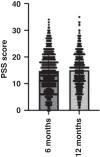Maternal perceived stress and infant behavior during the COVID-19 pandemic
- PMID: 37500757
- PMCID: PMC10665182
- DOI: 10.1038/s41390-023-02748-2
Maternal perceived stress and infant behavior during the COVID-19 pandemic
Abstract
Background: Maternal stress has negative consequences on infant behavioral development, and COVID-19 presented uniquely stressful situations to mothers of infants born during the pandemic. We hypothesized that mothers with higher levels of perceived stress during the pandemic would report higher levels of infant regulatory problems including crying and interrupted sleep patterns.
Methods: As part 6 sites of a longitudinal study, mothers of infants born during the pandemic completed the Perceived Stress Scale, the Brief Infant Sleep Questionnaire, and an Infant Crying survey at 6 (n = 433) and 12 (n = 344) months of infant age.
Results: Maternal perceived stress, which remained consistent at 6 and 12 months of infant age, was significantly positively correlated with time taken to settle infants. Although maternal perceived stress was not correlated with uninterrupted sleep length, time taken to put the infant to sleep was correlated. Perceived stress was also correlated with the amount of infant crying and fussiness reported at 6 months.
Conclusions: Mothers who reported higher levels of perceived stress during the pandemic reported higher levels of regulatory problems, specifically at 6 months. Examining how varying levels of maternal stress and infant behaviors relate to overall infant developmental status over time is an important next step.
Impact: Women giving birth during the COVID-19 pandemic who reported higher levels of stress on the Perceived Stress Scale also reported higher levels of infant fussiness and crying at 6 months old, and more disruptive sleep patterns in their infants at 6 months and 12 months old. Sleeping problems and excessive crying in infancy are two regulatory problems that are known risk factors for emotional and behavioral issues in later childhood. This paper is one of the first studies highlighting the associations between maternal stress and infant behaviors during the COVID-19 pandemic.
© 2023. The Author(s).
Conflict of interest statement
The authors declare no competing interests.
Figures





References
-
- Parodi, S. M. & Liu, V. X. From Containment to Mitigation of COVID-19 in the US. JAMA323, 1441–1442 (2020). - PubMed
-
- Lee, E. & Parolin, Z. The Care Burden During COVID-19: A National Database of Child Care Closures in the United States. 10.31219/osf.io/t5d3q (2021).
MeSH terms
Grants and funding
LinkOut - more resources
Full Text Sources
Medical
Research Materials

